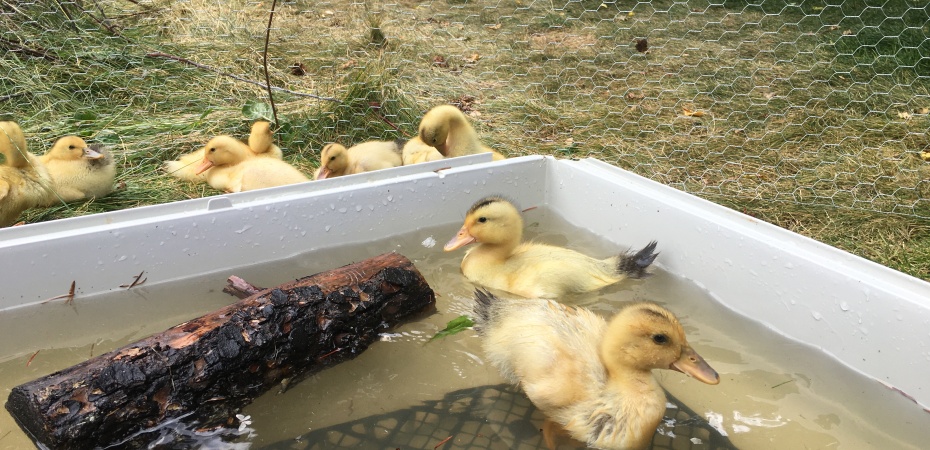Adding this amazing duck to the Rose Hill Farm animal roster is an adventure!
Updated 7-Feb-21
I am not sure where this story is going to end, but getting ducks has been a life long dream of mine. In 2020, the opportunity to try keeping ducks suddenly presented itself out of the blue, and it has been an incredible learning curve to wrap my head around the whole ducks vs chickens thing. Here’s what I am learning along the way, and you can follow along with me as I discover the utility of including ducks on my small farm.
A Little Background
My favorite childhood memories are those where my Dad took me to feed ducks. It was “our thing” to do, and rarely a week would pass that we were not out on a walk somewhere that included taking a snack to some ducks somewhere in the city of Vancouver during the summer. Sometimes it was the at the neighborhood golf course. Other times we would drive to Burnaby Lake, Stanley Park or out to Richmond. I LOVED them and spending time with my Dad was cool too. I wanted nothing more than to reach out and just touch a duck, but my Dad would remind me that they were wild and to keep my hands to myself.
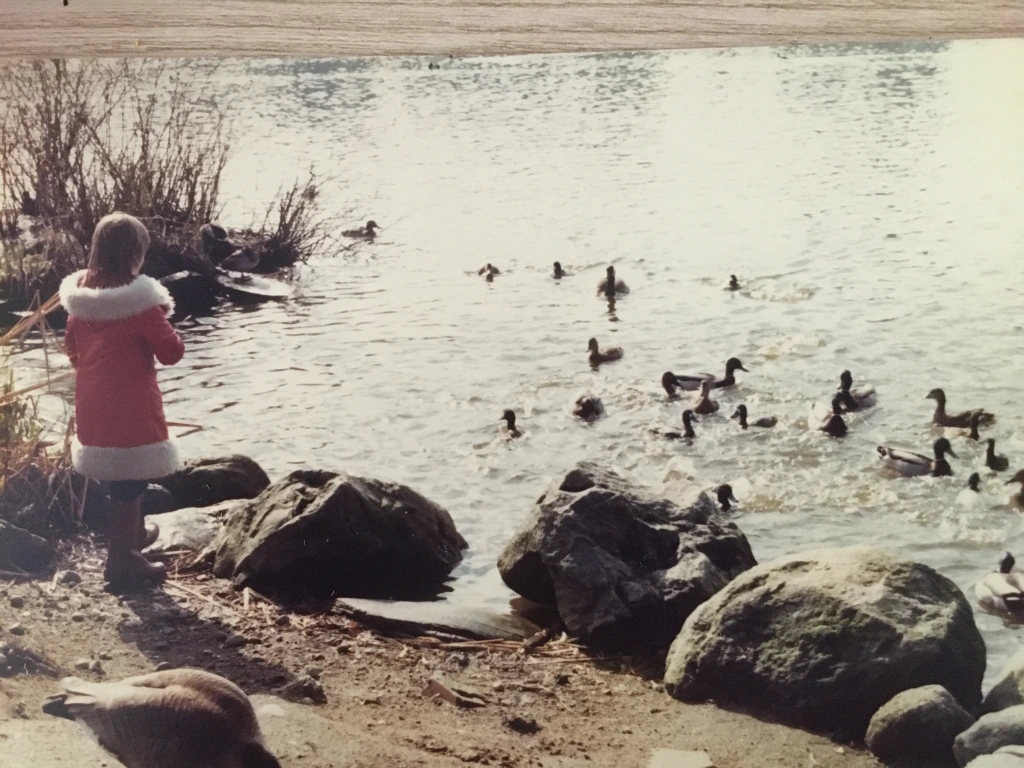
Our local ducks were almost exclusively Mallards back then, with a handful of other water birds thrown into the mix like Canada Geese, Coots and the occasional Swan. I marveled at their colors and funny behaviors, and all that quacking. I never grew tired of trying to lure them in closer so I could get a better look. And oh how I would dream of just touching them, just once.
But I never really believed that I would own ducks myself. It just didn’t seem likely given that I associated ducks with BIG ponds and estuaries, and how would that ever work in my grown up life?
That’s what I thought at least, until 2020, when my friend Jeff asked me to start caring for his two (LOUD) ducks. He was concerned that the neighbors in town would complain of how loud these two girls had gotten and could I please take care of them for a while.
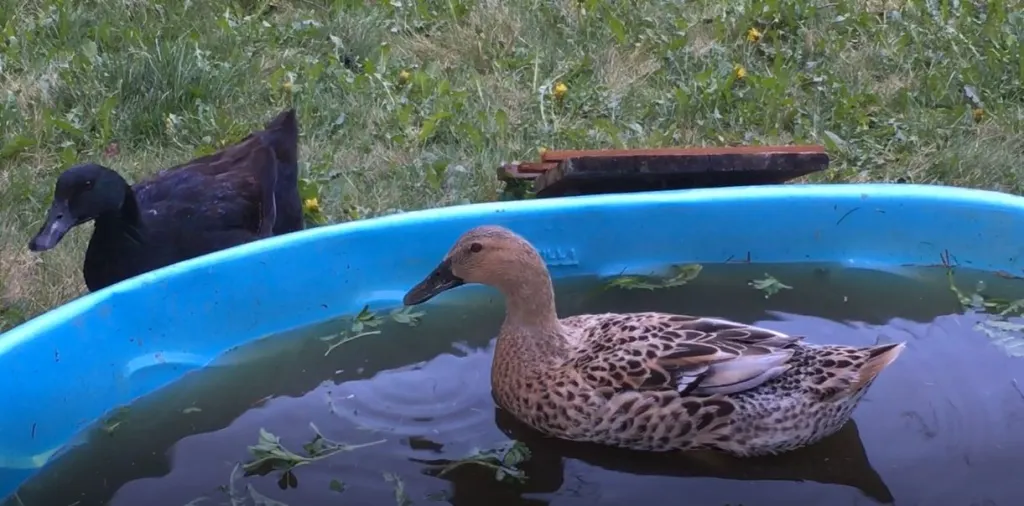
That’s how Ginger and Black Beauty came to Rose Hill Farm. I swore up and down to Jeff that this was a temporary favor and he just laughed at me. Of course I was charmed by them. Imagine a childhood fan of duck feeding now being given the chance to feed ducks every day!
I gave the two girls an old brooder house, a kiddie pool and an electric mesh pen in the orchard. Within two minutes of arriving at the farm Beauty had caught herself a giant worm that she was swinging wildly around like a spaghetti noodle. She was thrilled with her new home to say the least, and proceeded to hunt for food, happily wagging her tail. To be honest I was probably hooked for life right about then.
Black Beauty is a Cayuga and Ginger is thought to be an Ancona cross (or maybe a Khaki Campbell cross). Lovely girls to be sure. Of course they were not going to let me pet them, but WOW I had ducks for the first time ever. And I was completely sure my Dad was up there somewhere with the angels smiling at me.
One thing led to another with me, as it always does. My heart said, “Well, if you are going to have ducks at all, then you should have your Favorite Ducks, right?” And how could my head argue with my heart?
My all-time favorite duck is the Silver Appleyard. That may sound a little strange given that until July 2020 I had never actually seen one in real life. But in photos they look pretty much like a silvery colored Mallard, with a lot more color variation among the birds.
I love everything about the Silver Appleyard Duck story because it matches my own mindset when it comes to small-scale farming. Why settle for what exists right now when you can breed something that suits your needs? And that is exactly what Reginald Appleyard did.
According to a post by Harvey Ussery, Reginald Appleyard set out in the 1930’s to breed a duck that combined:
- Beauty
- Size
- Lots of big white eggs, and
- Lots of breast meat
In fact it was Harvey’s book – The Small Scale Poultry Flock – that introduced me to the Silver Appleyard Duck as a perfect breed for a small farm (and if you don’t own this book, you are missing out – it is my go to for everything regarding flock management).
So once the mental barriers to owning ducks had been crossed by Beauty and Ginger, there was nothing to be done but track down some Appleyard ducks and see what would happen next.
Finding Appleyards
My first thought was simply to track down a Silver Appleyard drake to keep Ginger and Beauty company. They had come from a bigger flock and the idea of giving them a boyfriend made sense.
A search of sale listing by me, my friend Jeff, and my sister Dee, turned up nothing. There wasn’t a drake (young or old) to be had at the time we started our search. I was really disappointed.
In the grand scheme of things, it was really wasn’t that surprising that I couldn’t find these ducks readily available. Silver Appleyards are listed as Threatened by the Livestock Conservancy.
A Threatened Heritage Breed of livestock or poultry is one that has fewer than 1,000 annual registrations (active breeding animals) in the US and less than 5,000 animals globally. The Livestock Conservancy tracks these numbers as best as they can because protecting the genetic diversity of our food animals is critical if we hope to adapt to a changing world.
With no mature birds available, the next plan was to find eggs. I have incubators that can be adapted for different types of bird eggs so why not try hatching duck eggs, right?
My sister Dee found someone near where she lived in Langley and made arrangements for 12+ eggs (whatever was available by the day she was leaving) to bring up with her when she came to collect the chicks I had hatched for her. That plan worked and I knew I had at least that many eggs on the way in June.
In the meantime, my friend Jeff found Silver Appleyards in Quesnel and he arranged to get a half dozen ducklings as well. More on the Quesnel ducks a little later.
Incubating The Duck Eggs
The eggs were a little dirty when they arrived which had me worried. My experience with chicken eggs is that this amount of dirt would be a problem. But I was afraid to clean them because cleaning chicken eggs is also a no-no and can affect the hatch. I decided to just go with it and set the eggs as they were. Later I read of several duck breeders who clean the eggs before setting. Turns out duck egg shells are a LOT harder than chicken egg shells, which might account for this difference in handling preferences. Still, I left the experiment of cleaning the eggs first for another day. . . . every time you hatch your own eggs you learn something new. It is as much an art as it is a science.
I started out with a temperature of 37.4 C (99 F) and 55% relative humidity. On Day 8 of the hatch I added a 40 min cooling period with the Ovation settings. I had read recommendations that put this cooling period at anywhere from 30 to 90 min or even longer, but I erred on the side of caution and kept the cooling period short. Then at lock down, which is Day 25 for ducks, I decreased the temperature by 1 degree and increased the humidity to 65%. Hatch Day is Day 28 for ducks, a week longer than for chickens.
It was a nerve wracking wait, those last few days hoping that the ducklings would hatch. At lock down I could see by candling the eggs that I had 15 fertile eggs in the set. The hatch started early and was very spread out. I ended up with 12 ducklings on my first try! WHEW! And OMG I had ducklings!
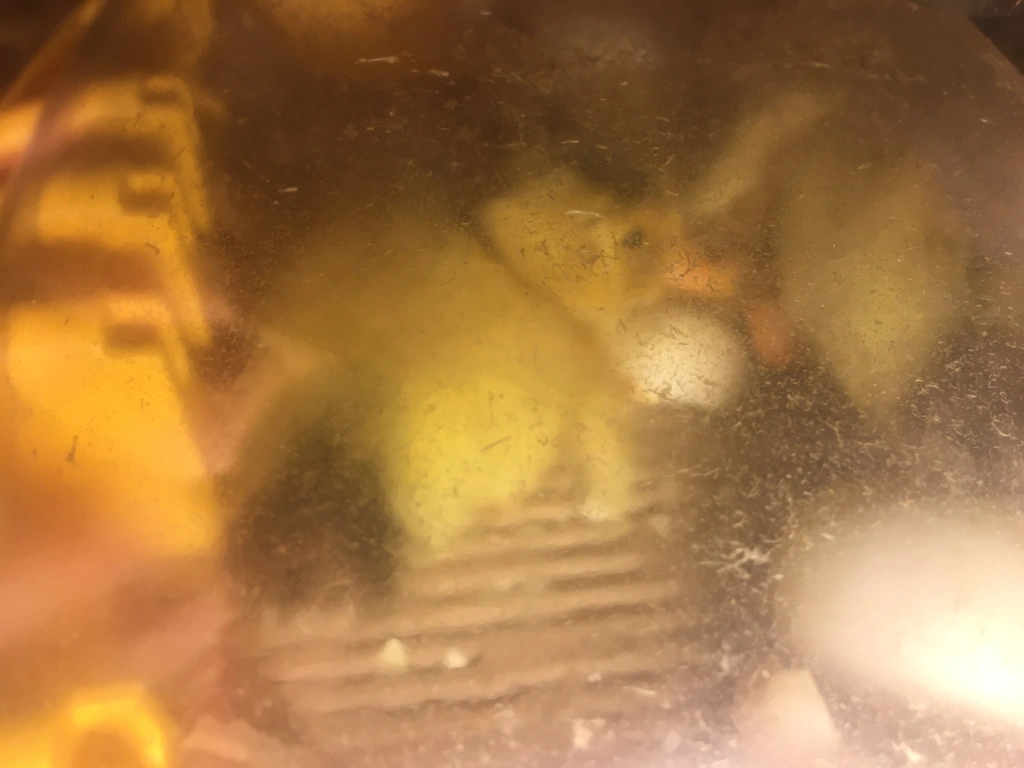
Raising Ducklings: Day 1 in the Indoor Brooder
The first thing I learned was that raising ducklings is NOTHING like raising chicks!
I could not have imagined just how different these little creatures could be. For starters, ducklings are HUGE compared to even the biggest chick I have ever raised! It is unreal how a bird that size ever fit into the egg at all. They expand exponentially upon hatching it seems. So it was a good thing that I had only 12 ducklings to work with!
I followed the suggestions of Lisa Steel for setting up a duckling brooder, using the supplies I describe in my post on Brooder Supplies for ducklings. The microfiber cloths, non-slip mat and the messy-cat dishes were a resounding success! And good thing too, because ducklings are MESSY!
It was worth every penny to buy the extra supplies specifically for the ducklings. I cannot imagine how hard it would be to keep ducklings clean with shavings or other types of bedding. Their affinity for water is immediate and they get it everywhere! But the clothes make it really simple to just change out the messy spots and carry on.
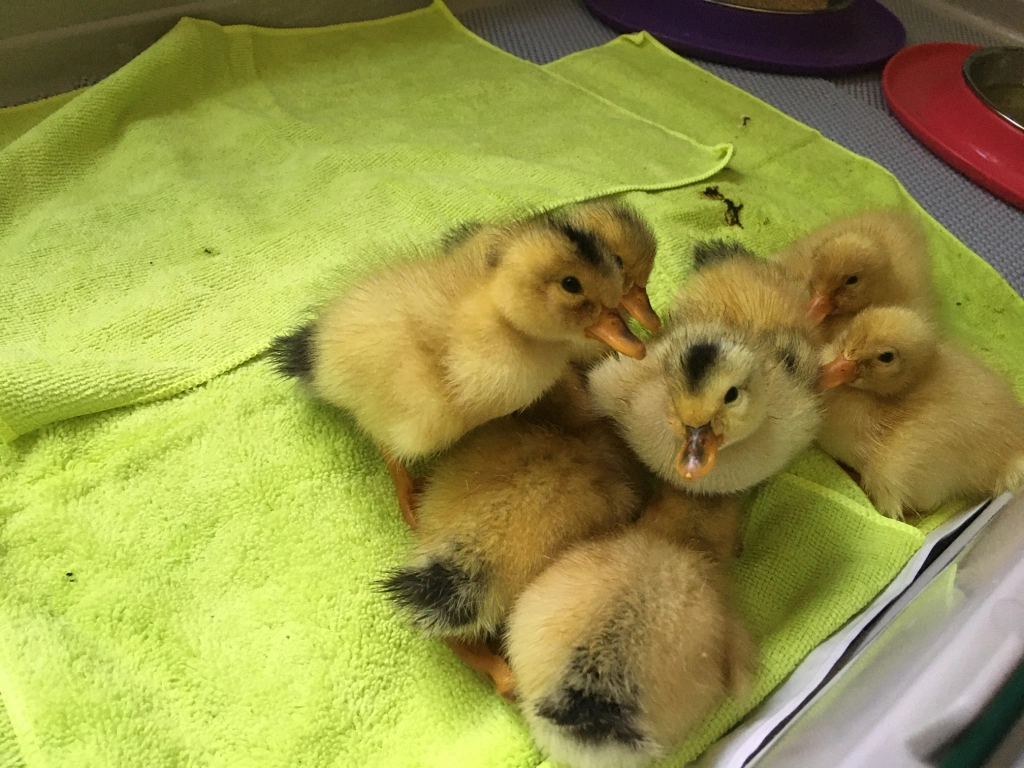
I was able to find a turkey/game bird/waterfowl starter crumble where I usually buy my feed at the Lillooet Timbermart. I used the shallow messy cat dishes and made sure to wet the crumble down well, essentially making soup, so the ravenous little ducklings didn’t choke. Ducklings grow like wildfire in their first two weeks of life, so keeping up on the feed and providing clean water can mean checking several times a day.
I think one of the things that surprised me the most was that the ducklings sounded a lot like chicks. I had no idea that they don’t learn to quack until much later on. The other surprise was that their wings are ridiculously tiny, so much so that if a ducklings flips over it just turtles around for a long time before it can right itself. I just had no idea.
Day 4 – Introduction to (Supervised) Water
The ducklings were in their messy-cat water dish so much that on Day 4 post-hatch I let them explore a little more water by putting some in a painting tray in the bathtub. I carried the ducklings in there and then let them run around and explore. They were delighted with the deeper water!
Again – I simply could not believe how big they were in just a few days! They only used the painting tray a couple of times before I abandoned that and just put the water into the bathtub itself.
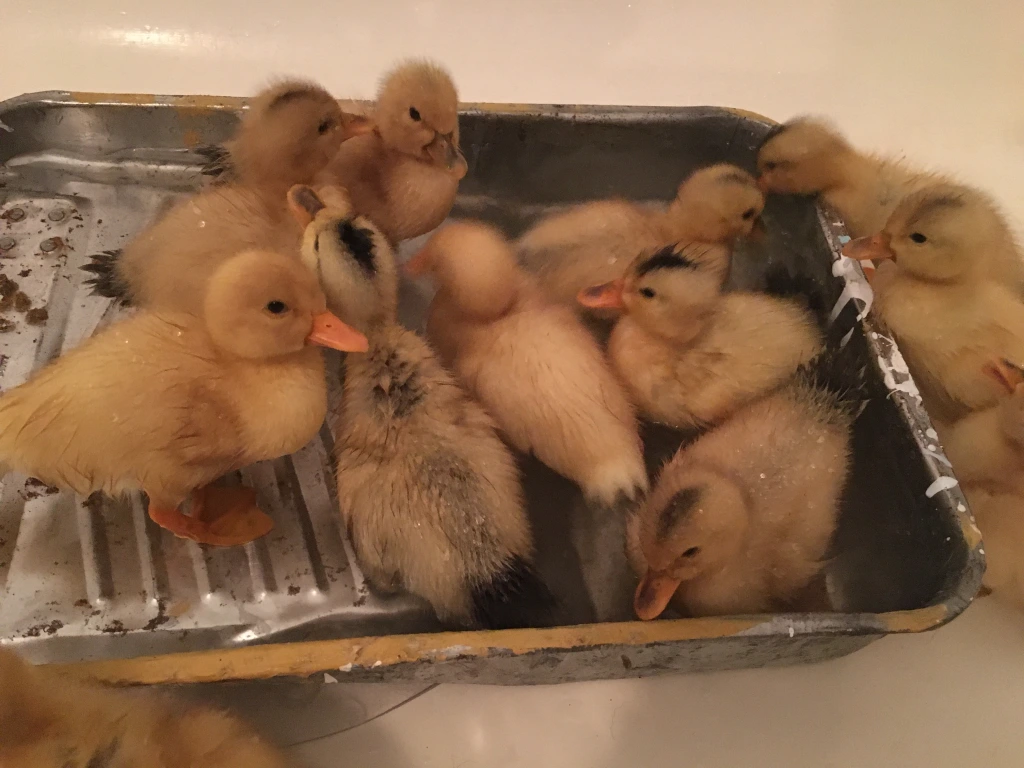
The ducklings loved being able to splash in the water. But it is important to remember that ducklings raised without a mother duck are NOT water proof. Their feathers soak up water like sponges and they can easily drowned. Only short and highly supervised visits to the “duck pond” are allowed until they have mature feathers that prevent them from water-logging (don’t worry – you can see the change in how fast they get soaking wet as time goes on).
1 Week Old – Moving Outside
By the time the ducklings were 1 week old they were taking up a LOT of room in the indoor brooder. I could not believe my eyes at that the size of them! They were outgrowing their indoor brooder cage at an astonishing rate and the mess was crazy!
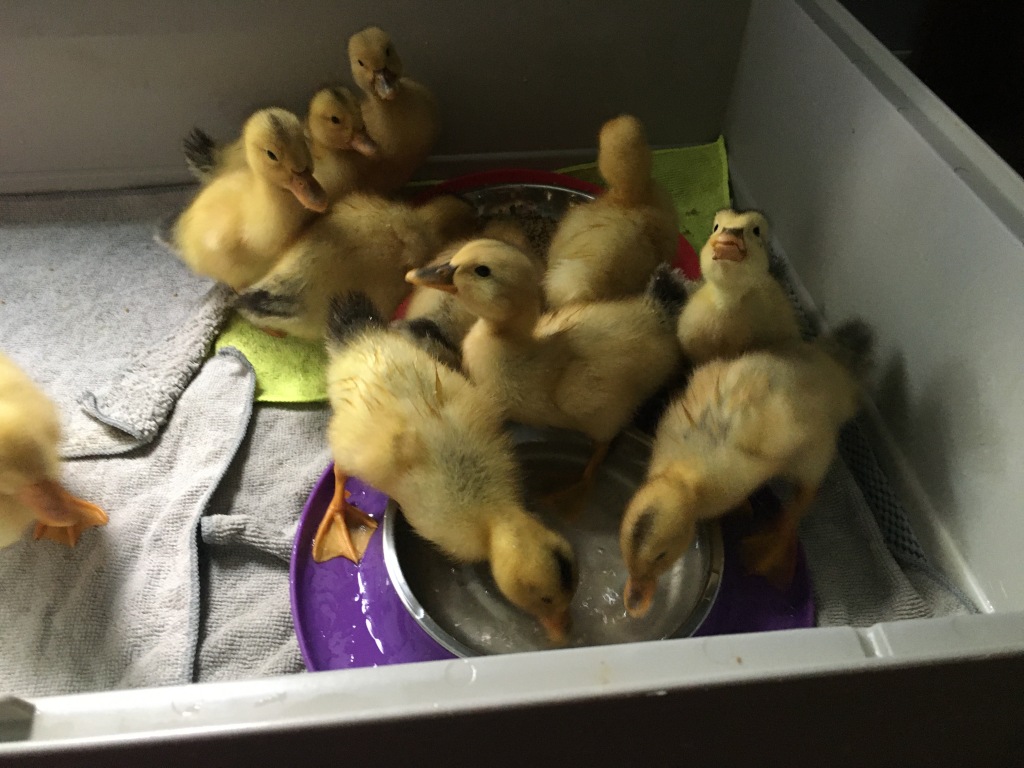
At this point they were no longer sleeping inside their little brooder house (mostly because they didn’t all fit) and they were not spending much time on the heat mat. Also, it was summer, so the ambient temperature was more than enough to keep the ducklings happy at this point anyway.
The other problem was they were messing up that brooder faster than I could clean it now – in only 1 week! I definitely recommend having two complete indoor brooders set up for ducklings. That way you could have a clean one ready, transfer the ducklings over and then clean and reset the first one. It would be so much simpler.
Because I didn’t do that, I had to move the ducklings to a Rubbermaid bin while I cleaned their brooder and then move them back. It worked, but it meant I had to hurry with the cleaning. And cleaning meant hauling the indoor brooder outside to hose it off because the ducklings are THAT messy!
So on Day 7 of their little lives, they got moved to the outdoor brooder. I have a 4×6 triangle brooder pen that I built for chicks, but which works perfectly for ducklings too. It can just be slid around on the grass, providing fresh clean ground as needed. It has the benefit of sunshine, fresh air, grass and BUGS! The ducklings loved it!
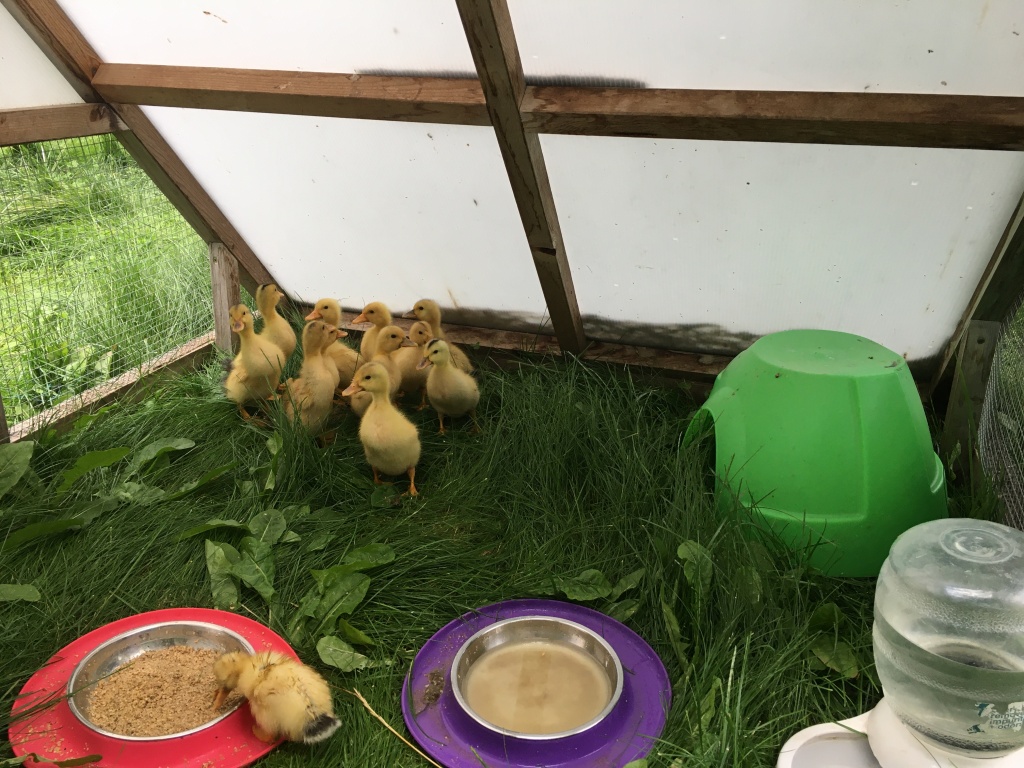
The other benefit of moving outside was now the ducklings could be given access to a bigger swimming pool! I used the bottom of the indoor brooder cage as a swimming pool which I placed near the outdoor brood and surrounded with 24″ chicken wire to prevent the ducklings from wandering off.
For the pool, I added one of those plastic trays that you get bedding plants in as a landing point so the ducklings could choose how much actual swimming they wanted to do. I built a little ramp into the pool out of some bark and firewood. Pool time was a big hit!
But again, the ducklings only had access to the pool about once a day, in the afternoons, when I could sit and watch them. I was really impressed that the ducklings seemed quite fine with taking turns in the pool.
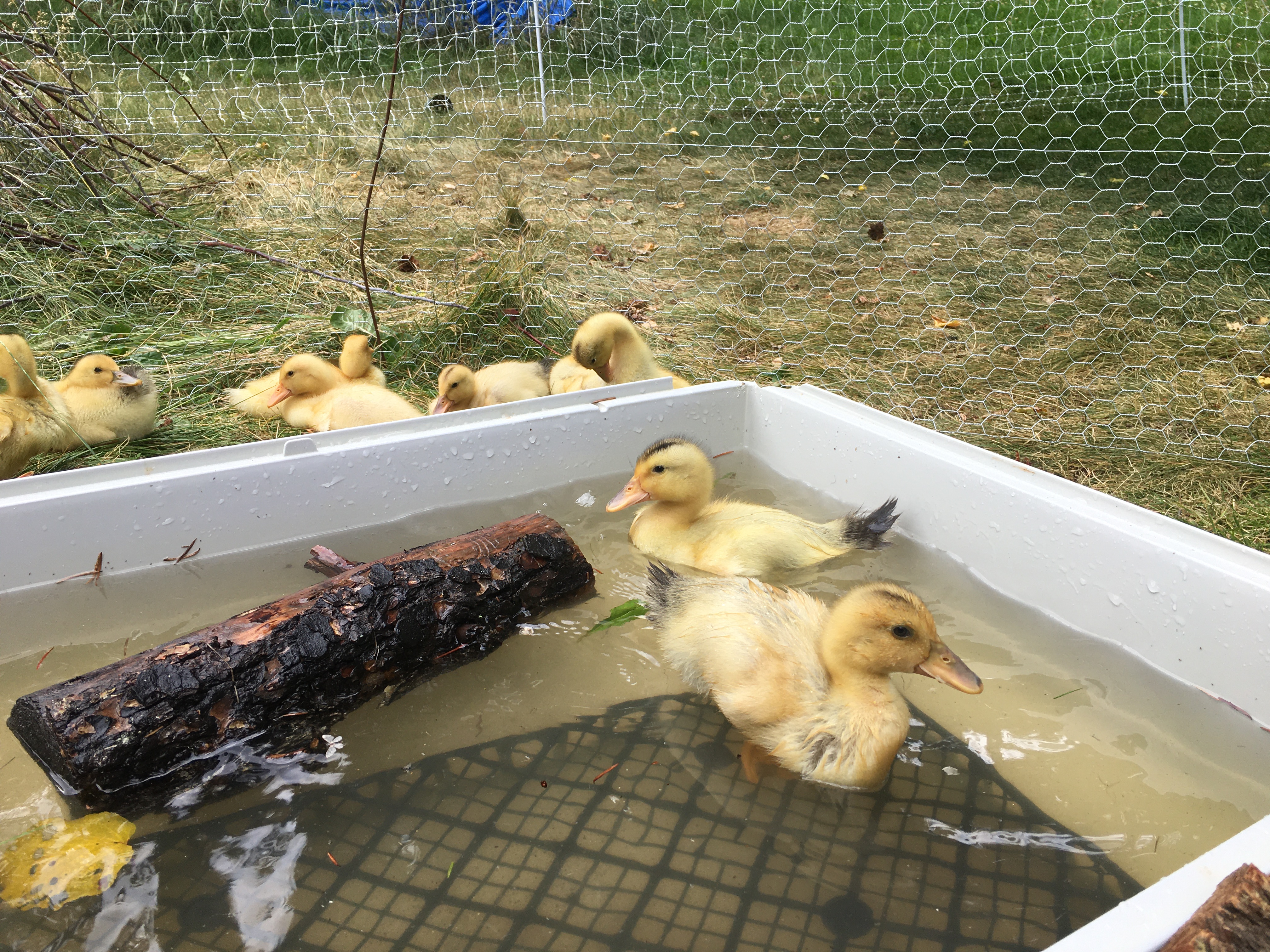
After they had their fill of swimming, the ducklings would stretch out in the sun to dry off. I have to say that “swimming the ducklings” was my favorite afternoon chore! It sure beat cleaning the indoor brooder, that’s for sure.
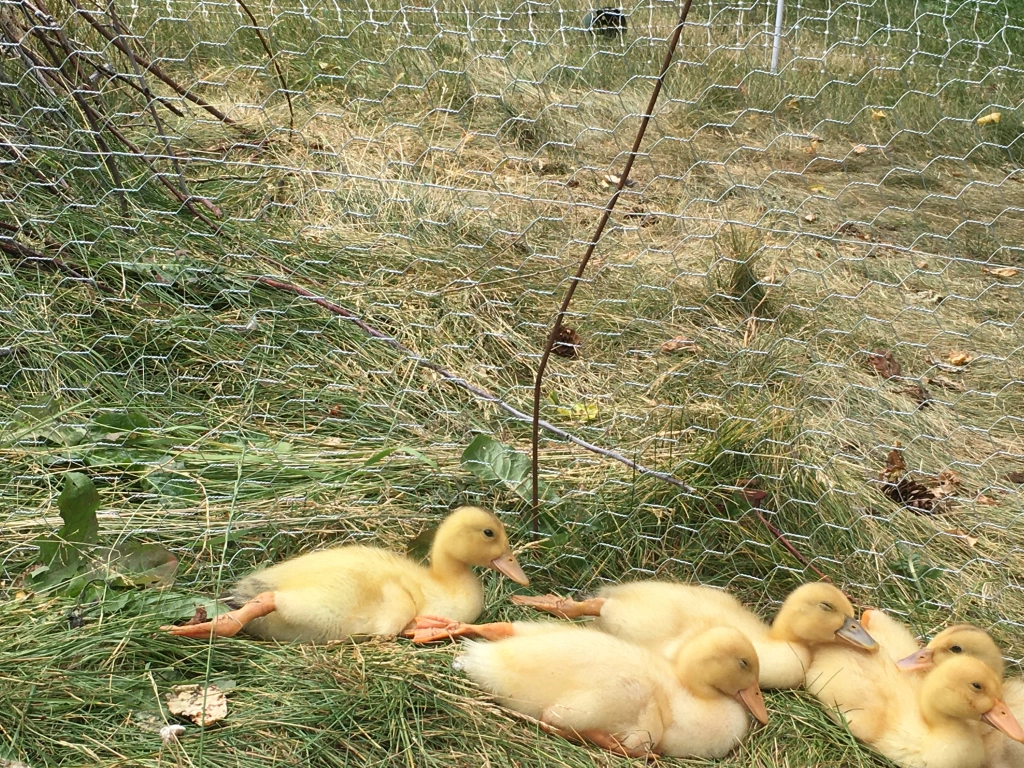
Rate of Growth
The rate at which Silver Appleyard duckings grow is nothing short of astonishing to me, having only raised heritage chickens myself. When I read that they reach finishing weights in only 7 to 10 weeks, I just didn’t believe it. Well, I believe it now! I’ve seen it with my own eyes, and it required no special treatment.
At 14 days, the ducklings could jump in and out of their brooder pond on their own. At 28 days (4 weeks) they were beginning to take on some of their adult colors and feathers. That meant that they were also nearly waterproof.
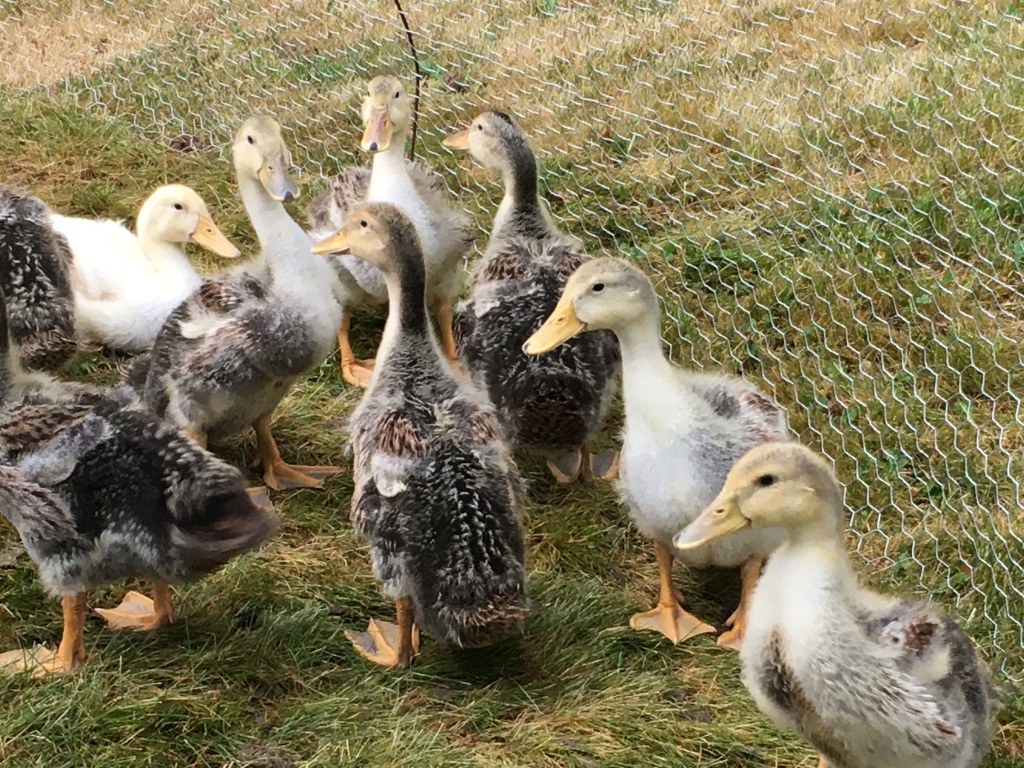
27 days old 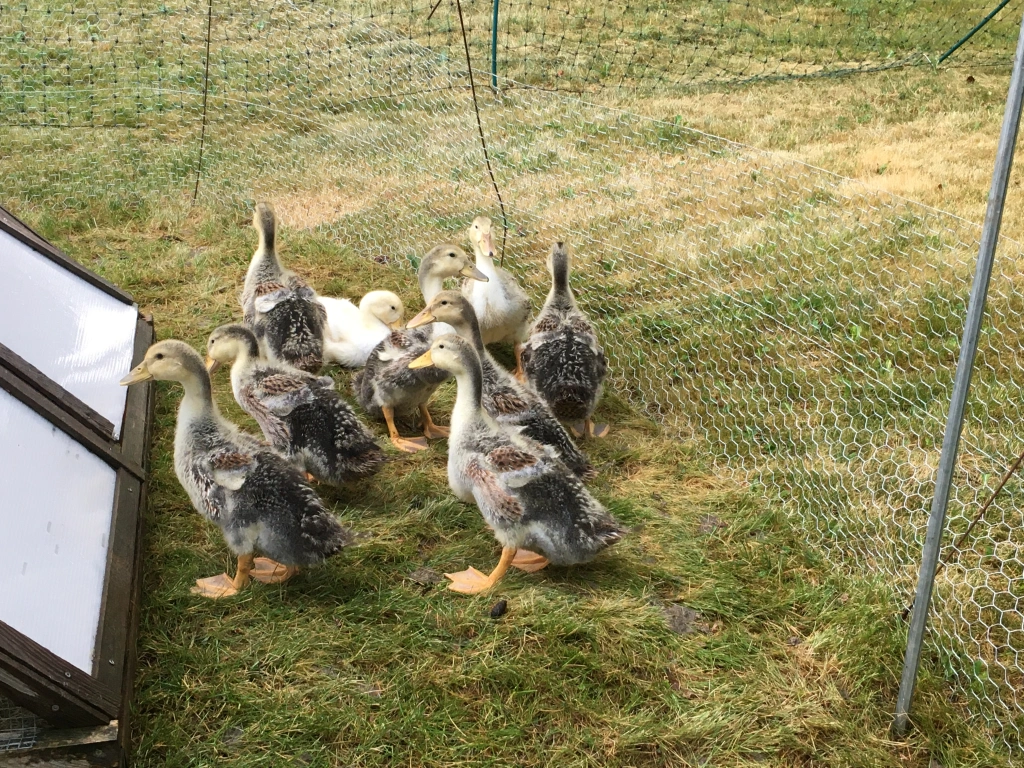
27 days old 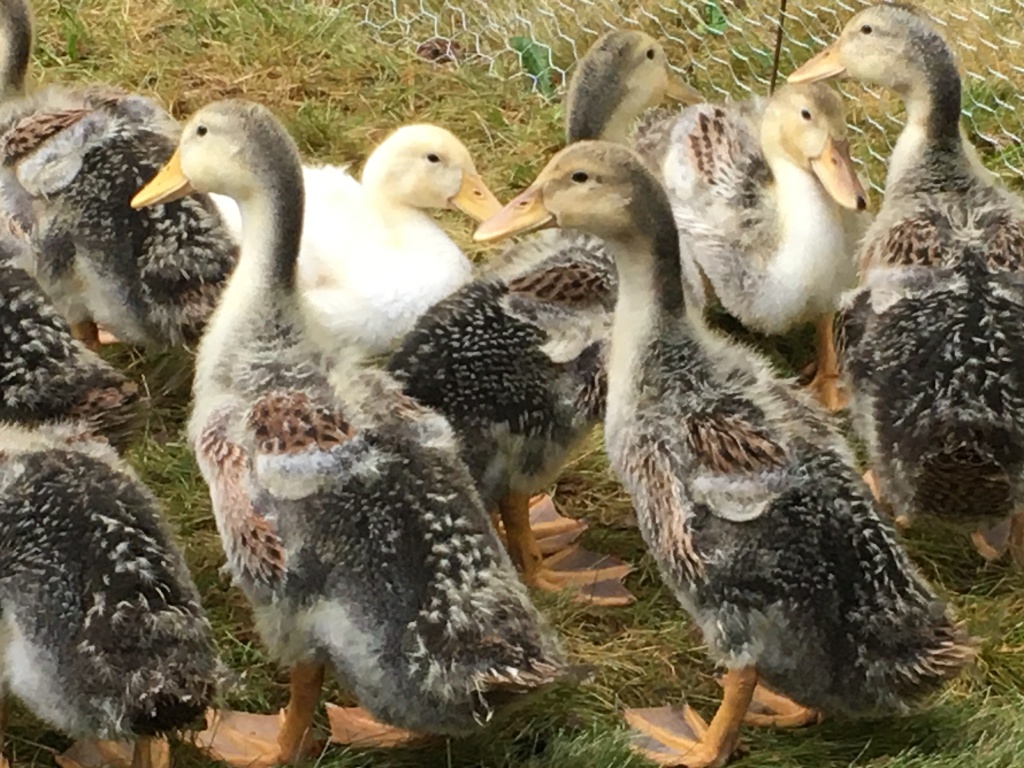
27 days old 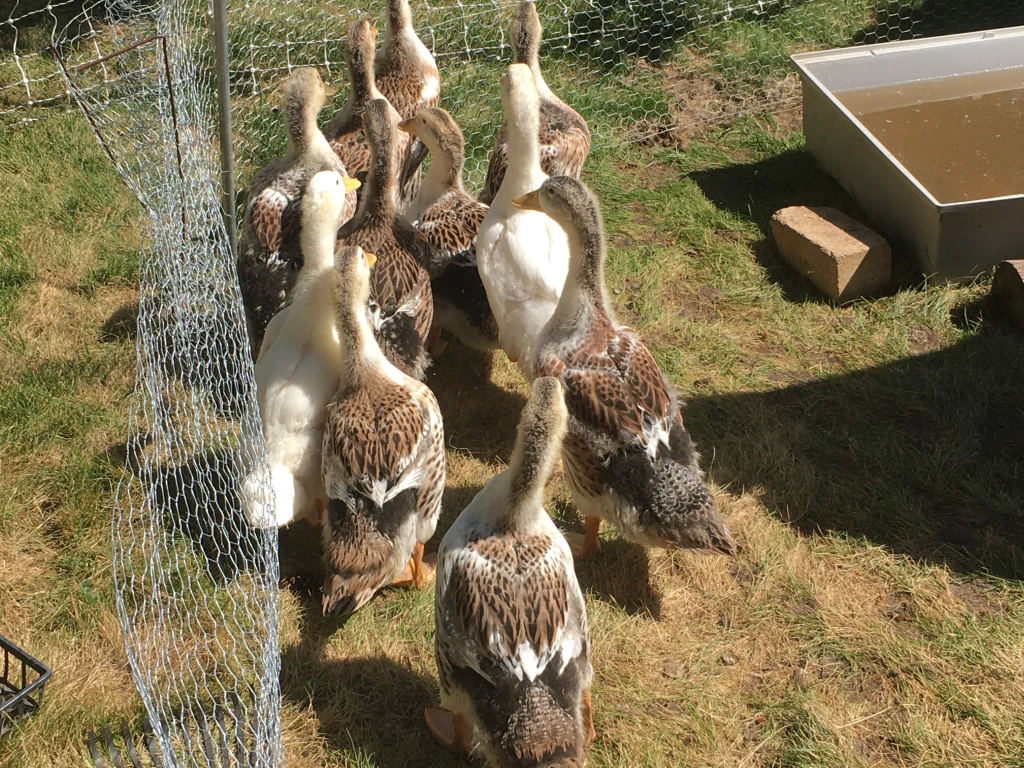
45 days old 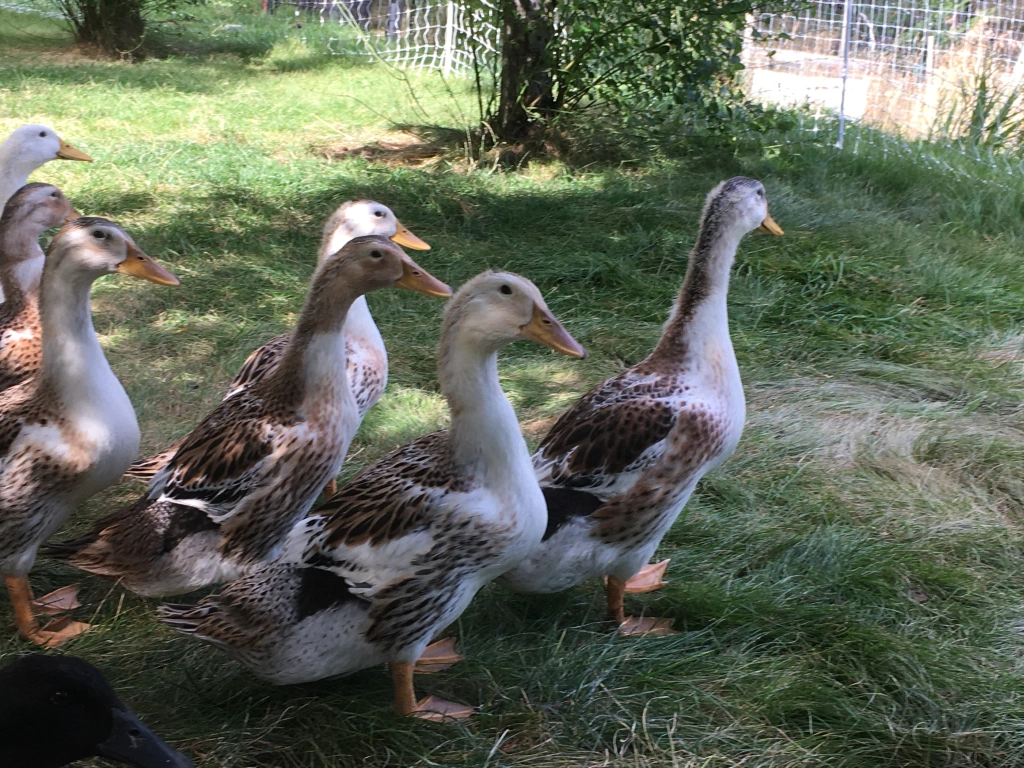
45 days old
When the ducklings were 6 weeks old I turned them into the orchard pen with Ginger and Beauty. There was some hissing and chasing, but for the most part everyone settled down in short order. Beauty seemed very happy to have a bigger flock back, but Ginger remained reserved for several weeks. Again this was NOTHING like introducing chickens into a group, where there is normally a tremendous amount of peaking, shrieking, chasing and violence that can last for days. The duck introductions were tame by comparison.
By 9 weeks old the Appleyards towered over Ginger and Beauty. There is no question that, depending on the desired size of table bird you seek, that harvesting could happen anywhere from 7 weeks and up. By contrast, 9 week old chickens still look like babies and are still confined to a brooder pen because the hawks would kill them.
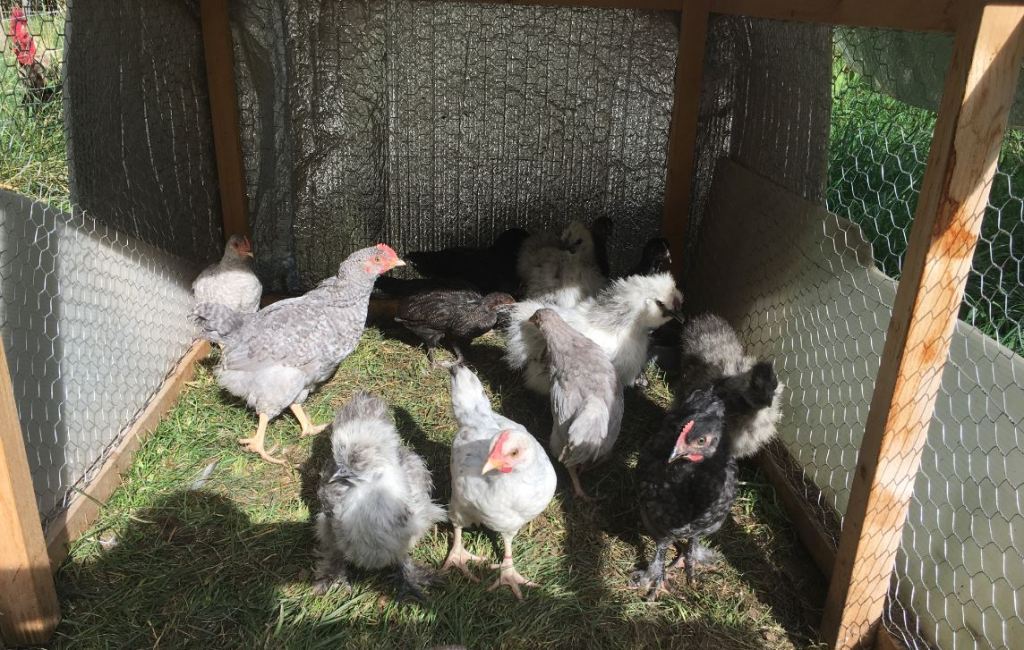
The Quesnel Appleyards
On August 27, Jeff brought over a trio of the Quesnel Appleyards to join my expanding duck population ( . . . .crazy how I went from 0 ducks to a flock of 17!?!?! – how DOES that happen? I think I need to create a group called Farm Addicts Anonymous!).
Jeff felt the Appleyard girls were extremely loud, louder than even Beauty and Ginger, so he donated the trio to my blossoming breeding program.
The Quesnel Appleyards are only 17 days older than my own, and there was very little difference in size at this stage. Because Appleyards are a Threatened duck breed, it’s important to use the best possible breeding practices to ensure continued vigor. The Appleyards that came from Quesnel represent a different breeding line than those from the Langley farm. That gives me a wonderful opportunity in 2021.
The combination of two separate lines means that I can breed each one independently, or cross them in one of two ways. I can cross the Quesnel drake to the Langley ducks or the Langley drakes to the Quesnel ducks. Perfect! Essentially that gives me three sets of lines: Langley pure, Quesnel pure and the Langley-Quesnel crosses. It means I can potentially sell out-crossed breeding trios in 2021. And this is a really great example of how much work it takes to implement the best breeding strategies for a Threatened breed. It’s also why you can expect to pay more from a small scale breeder who is producing high quality stock. It takes a lot of energy and resources to maintain these breeding lines.
To make all this possible, the Quesnel trio got green Z-bands from Chicken Hill. These zip bands are easy to use. Because ducks have such big webbed feet it should be pretty easy to keep the zip bands in place. The bands make it easy now to identify the three birds.
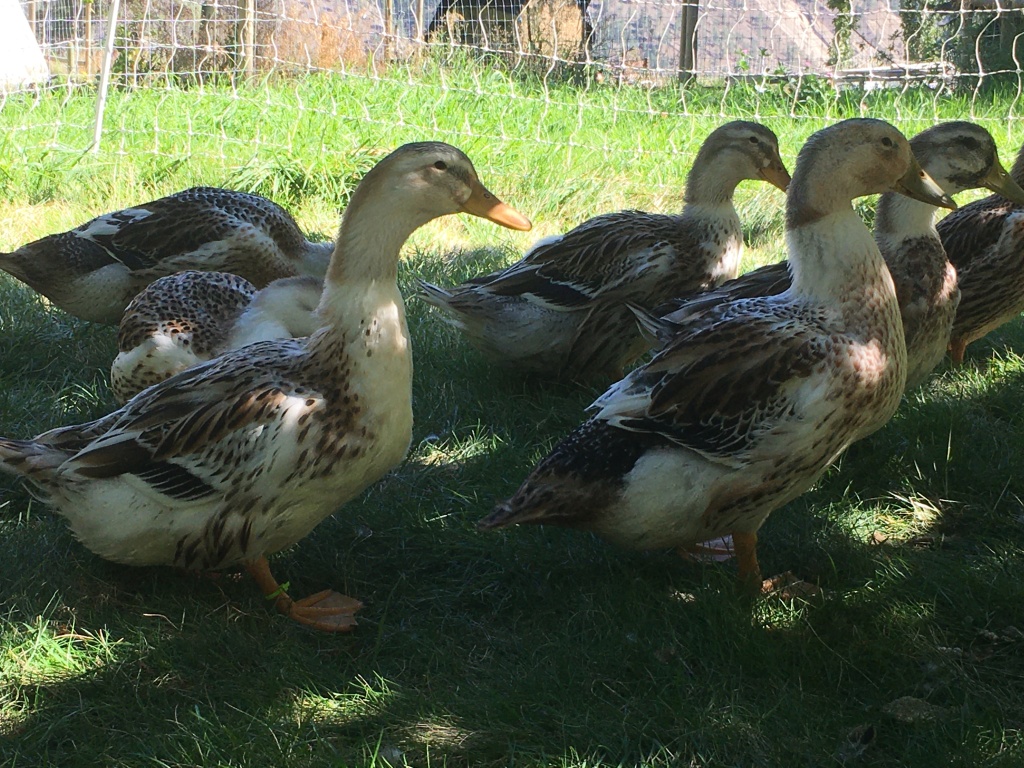
The Future Of Silver Appleyards at Rose Hill Farm
While this has been a very exciting summer, with a steep learning curve, there are more challenges ahead. I have never managed ducks through the winter and it can get very cold here, like -20 C (-4F) or even colder. I still don’t have a strategy quite worked out for where the ducks need to go. I need to build them a house and pen, secure for the winter when electric mesh doesn’t work well, because they have REALLY outgrown the brooder house they are still using. And, I need to make sure it is somewhere close to winter water. How many ducks should I keep all winter? That is a question and a half that I am struggling with right now. Soooooo, so, so, so much to do and winter is not many weeks away now!
Although it may seem counter-intuitive to some, eating the cull ducks (who don’t make the cut in terms of the breeding flock held over winter) is part of this story. I believe in dual purpose birds, and in raising my own meat in the most ethical way that I can. Even though the Appleyards are Threatened, they should still be raised and used for meat for several reasons.
Firstly, not every duck is a high quality breeding duck and cull ducks should be put to good use as food. Silver Appleyards are a gourmet duck – a feast – and I am looking forward to trying my hand at roasting one this fall.
Secondly, you only truly manage for what you use. In order to maintain the qualities selected for by Reginald Appleyard (the breed creator), ducks need to be eaten and evaluated for their quality of meat as a heavy-weight duck. When you stop worrying about meat production, you stop valuing that deep wide breast, their large size, and calm personalities, all of which contribute to the quality of their meat. That is why many flocks today are smaller than the breed standard calls for. Dual purpose breeds need to be maintained for both meat and eggs. Period. And these priorities need to be reflected in the breeding and culling process for the flock.
But the reality here is that the jury is still out on the future of Appleyards for Rose Hill Farm. Yes I have LOVED having ducks. However, will I still love them this winter? How are the substantial feed costs going to balance out? How much work is going to be to keep getting the water and cleaning their house when it is really cold? I have to feed this flock all winter before they will start laying eggs and producing ducklings that will add to my farm revenue next spring. Hard as it is, these are the reality checks that have to happen. Can I actually manage this flock or not? Only time is going to tell.
If I do end up keeping the Appleyards as part of my small farm plan, the I likely will register with the Livestock Conservancy and join the concerted effort to save the Silver Appleyard. I have to say this is part of my motivation in getting these ducks at all. I want to help save them.
In the meantime over the winter, I still have a LOT to learn about keeping ducks. That means I will be doing a lot more reading and researching about ducks, duck care and so on. I purchased Lisa’s book Duck Eggs Daily with my Christmas book gift card and LOVED it. This book, as well as everything I have read online so far, suggests that ducks are much hardier than chickens and suffer from fewer common problems (no mites, no lice, and fewer diseases). Still, it is the practical hands-on experiences that will help me decide if the ducks are here to stay or not.
Rose Hill Farm Silver Appleyard Ducks 2021
If you are interested in learning more about the Rose Hill duck flock and purchasing fresh eggs, hatching eggs, ducklings or table birds, visit the Silver Appleyard Duck post on the Breeding Flocks page.
You can follow along on this adventure with me by regularly visiting the Rose Hill Farm website, or by joining the e-mail list.

